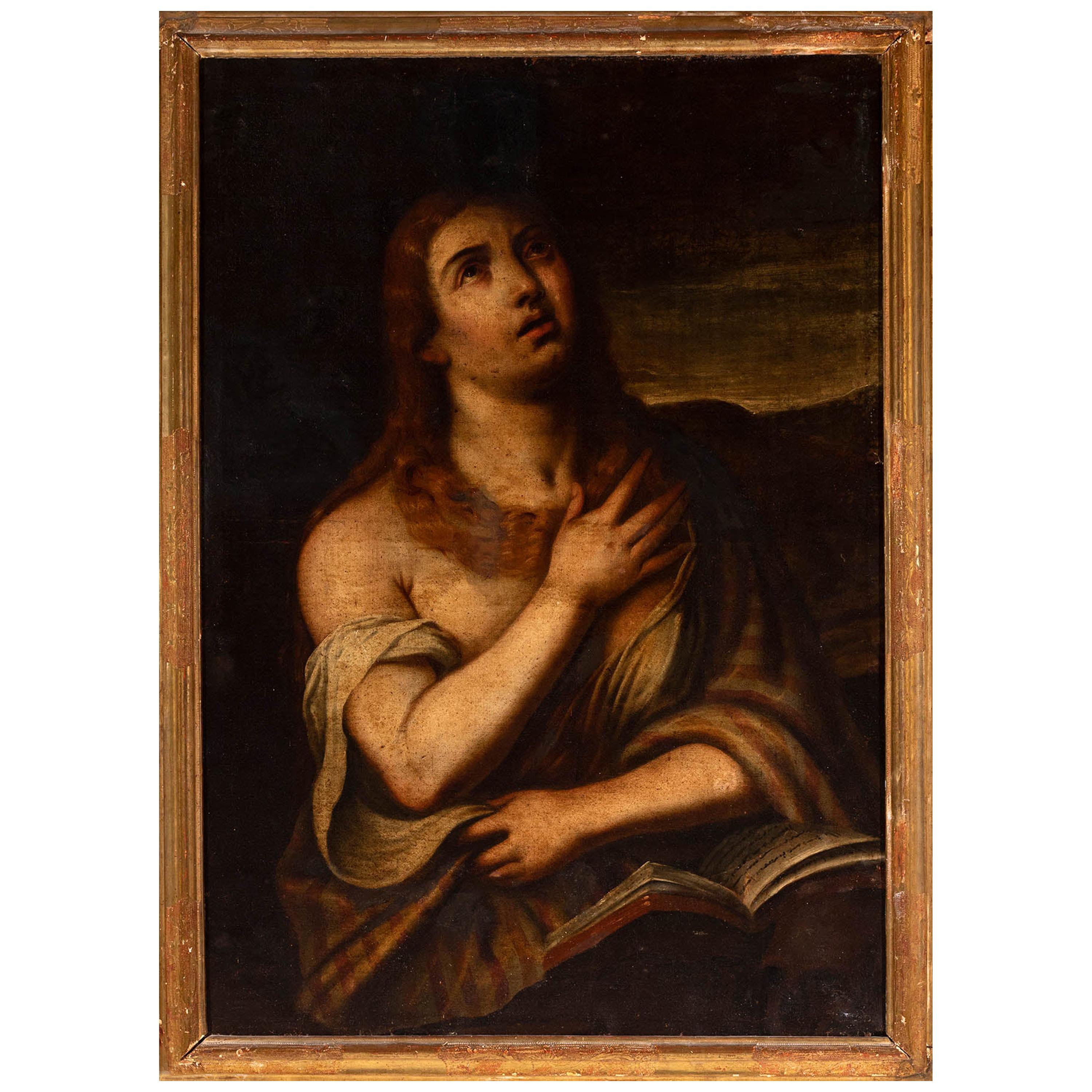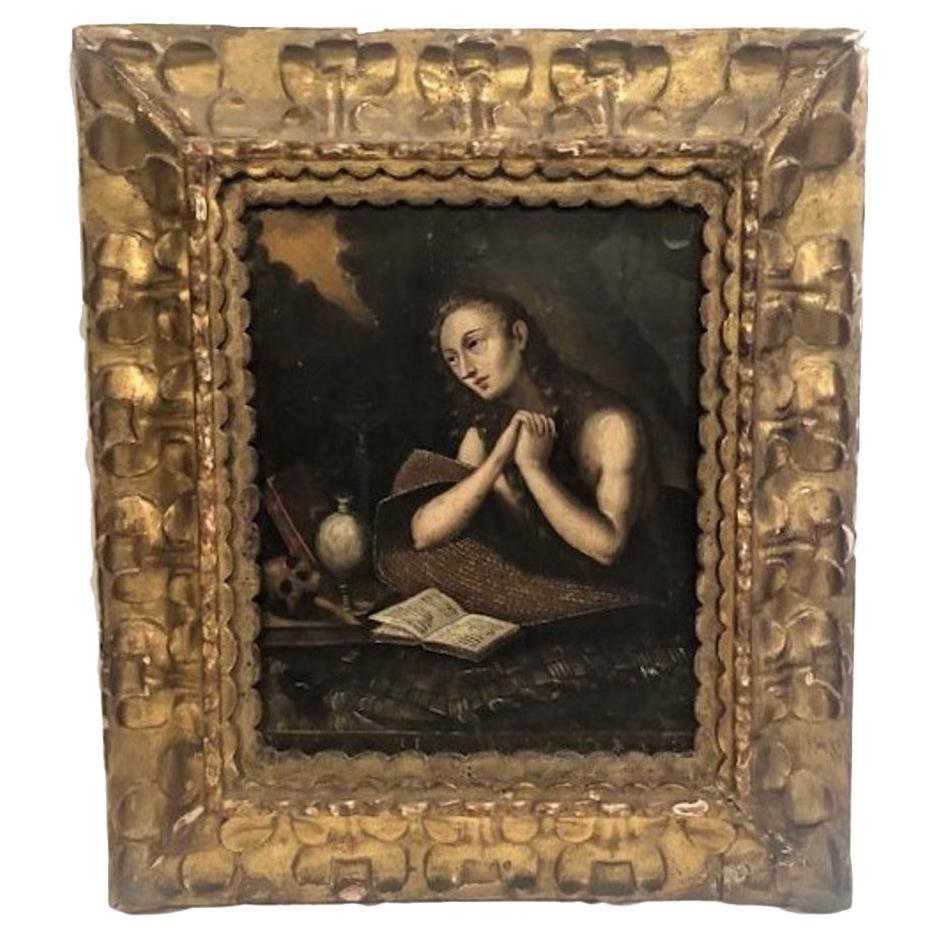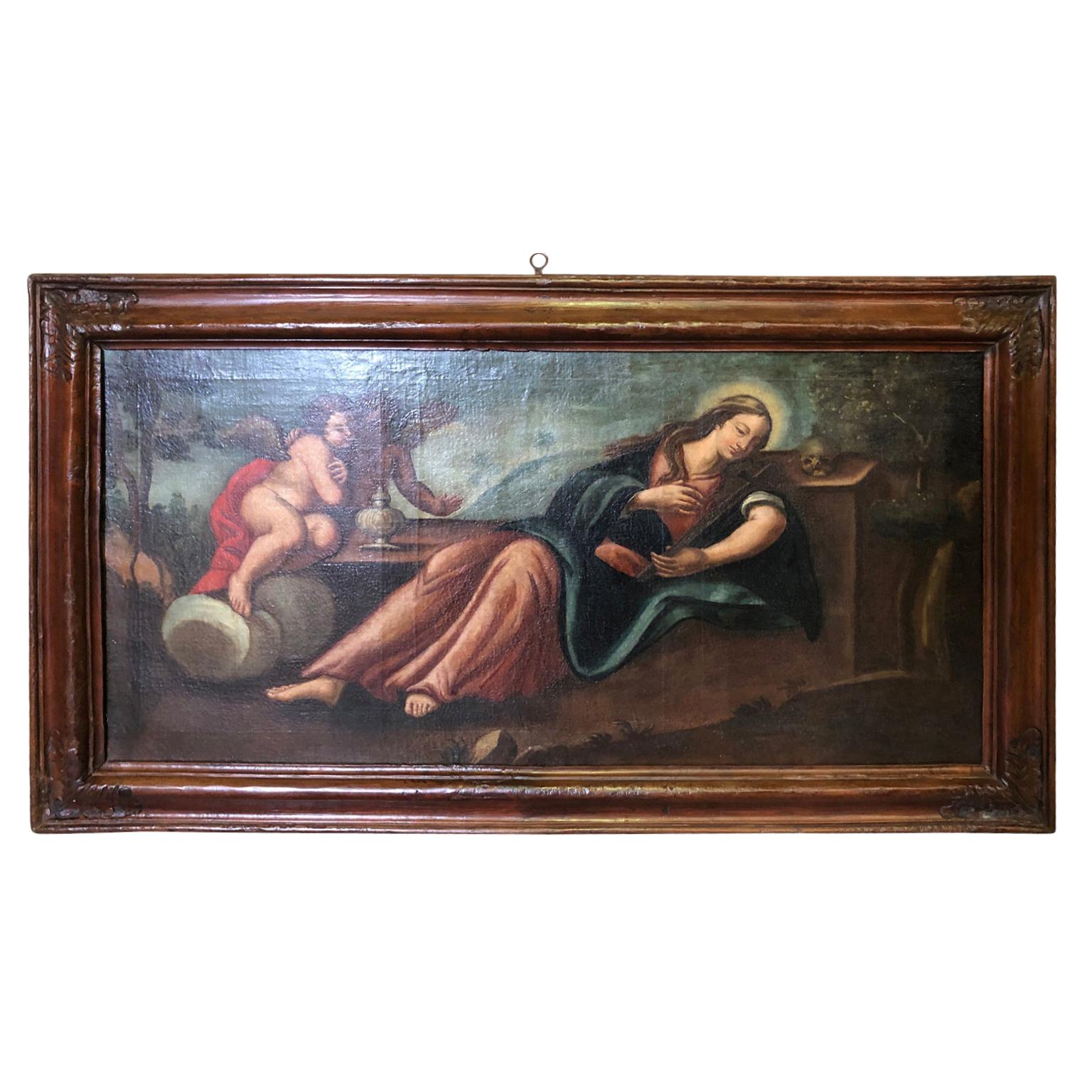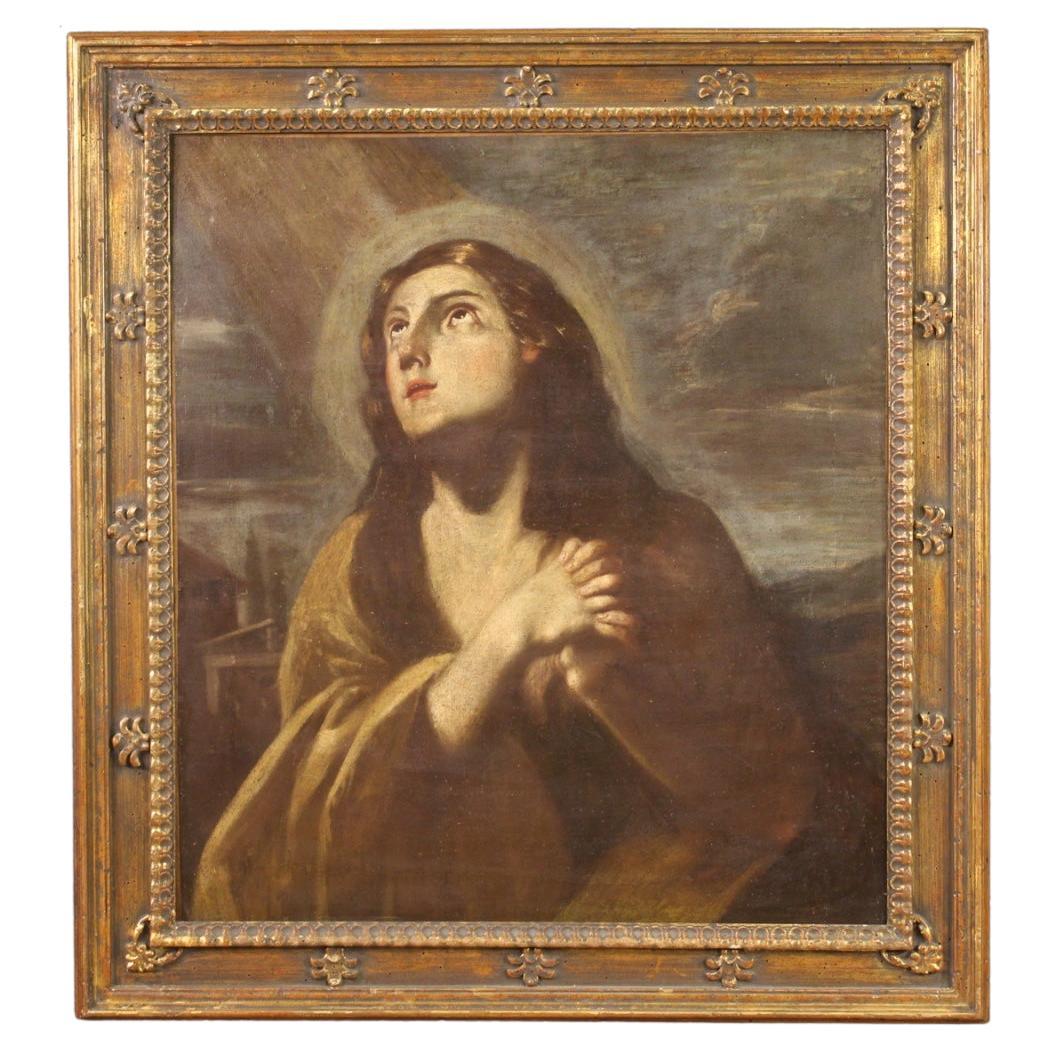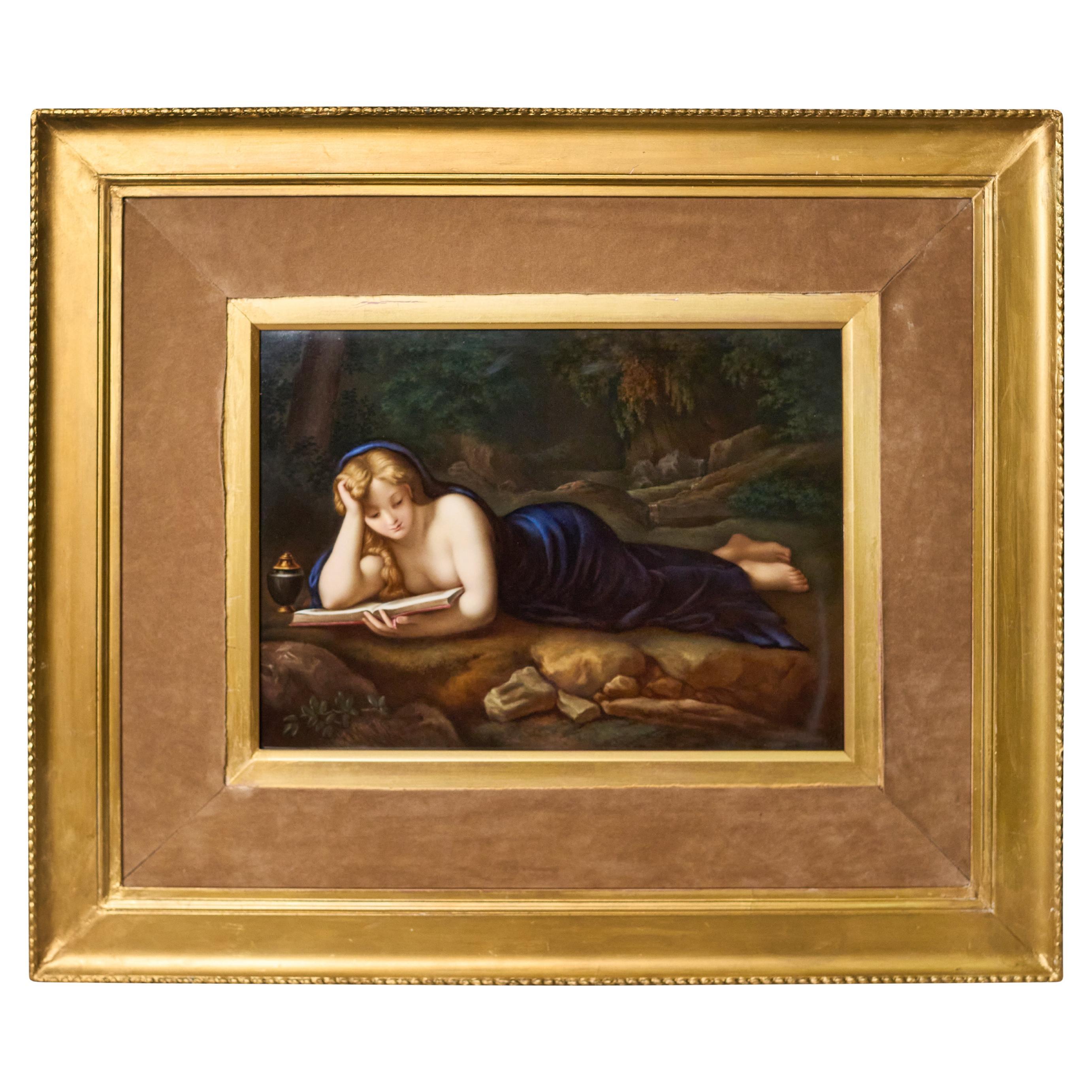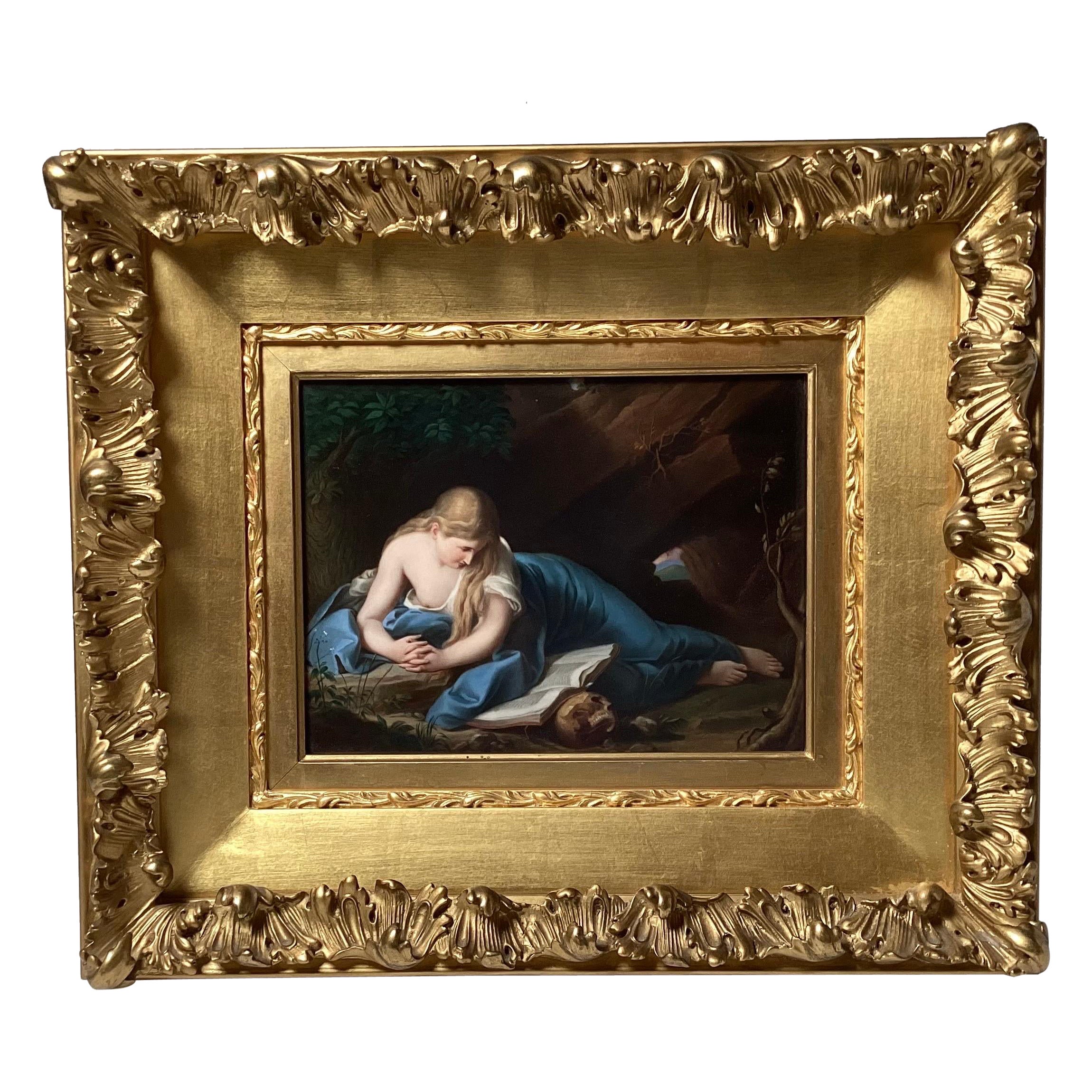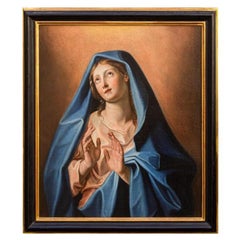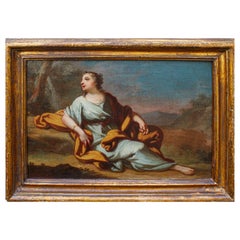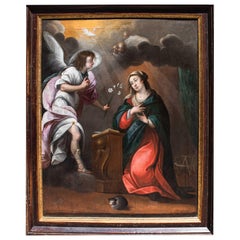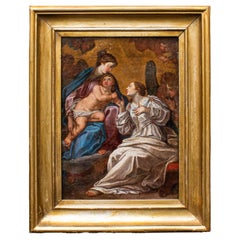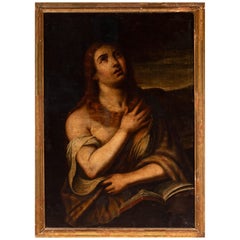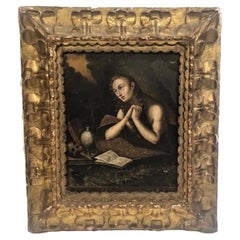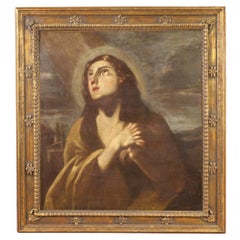Items Similar to 17th Century Penitent Magdalene Painting Tempera on Parchment by Genovese
Want more images or videos?
Request additional images or videos from the seller
1 of 5
17th Century Penitent Magdalene Painting Tempera on Parchment by Genovese
$3,357.70
£2,497.79
€2,800
CA$4,597.84
A$5,112.17
CHF 2,669.30
MX$62,227.60
NOK 34,059.04
SEK 31,911.69
DKK 21,314.85
Shipping
Retrieving quote...The 1stDibs Promise:
Authenticity Guarantee,
Money-Back Guarantee,
24-Hour Cancellation
About the Item
Giovanni Battista Castello, known as "Il Genovese" (1547-1637)
Penitent Magdalene
Tempera on parchment, 21 x 17 cm
Frame 26 x 22 cm
The precious tempera painting on parchment is to be referred to the hand of the painter Giovanni Battista Castello (1547-1637), called “il Genovese” to distinguish him from the homonymous contemporary, architect and painter, called “il Bergamasco”. Older brother of Bernardo, a famous painter of late Ligurian Mannerism, he began his activity in the field of religious goldsmithing, to which he soon joined the art of miniature, an art to which he ended up dedicating himself completely and with greater satisfaction, bringing it back to a success and to a disclosure that he had not known since the Middle Ages and which now found incentive and justification in the spiritual and cultural climate of the Counter-Reformation.
In the sources he is cited as self-taught; However, his assiduous frequentation of Luca Cambiaso's workshop is certain, where he drew all the cultural baggage that this center of artistic eclecticism involved and to which he added the experience of Nordic engravers, Tuscan-Roman mannerism, Venetian and Emilian ancestry, a of purified Baroqueism and, last but not least, the aspiration to elude artificial intellectualism, preferring an unconscious need for simplicity, purity, chastisement, that "primitiveness" that was identified, sometimes, even in the period of the Counter-Reformation, with the pietistic attitudes.
In the wake of the Cambiaso and the Tavarones, Castello was called to Spain by Philip II, where he mined for the king, in 1584, among other sacred books destined for the Escorial, an important Antiphonary. This commission brought him immediate reflex glory at home. His reputation was such that in 1606 the Most Serene Genoese government declared him an "excellentem" painter above the others eminent, and exempted from the laws, and chapters, to which the Professors of Painting were unworthily subjected in Genoa ".
The corpus of his works appears to be particularly large given the exceptional span of time of his intense activity, especially since, as quoted by Soprani, the painter used to keep "every single folder of his, even a simple sketch" and had filled "Some books of an infinite number of miniatures ... great care having no one go bad" also with the intention that "they would facilitate the path of those who wanted to undertake the miniature" (Soprani-Ratti, Vite de 'Pittori , Genoese Sculptors and Architects, 1769, pp. 110). Alizeri also mentions that in the Genoese patrician collections, for example that of Spinola, or that of the Marquis Pietro Rostan, who owned eight miniatures of the Castle, illuminated manuscripts and books were preserved,
In the parchment examined, intended for the Genoese patrician commissioning of images for private devotion, we find its typical harmonious and tuned palette, the execution is treated both in the chromatic material and in the design, the airy landscape is interpreted as pleasant nature and elaborated on several plans. The penitent Magdalene is depicted in the center in the foreground, surrounded by her typical iconographic elements, such as the skull, alluding to the transience of earthly existence, the scourge and the jar of ointments.
Similar works are preserved both in private collections and in Italian and international museums. Punctual comparisons can be made, for example, with the Baptism of Christ from the collection of Palazzo Mazzetti in Asti, or with the miniature depicting the Delivery of the Keys to St. Peter, now in Paris at the Louvre Museum.
- Creator:Giovanni Battista Castello (Painter)
- Dimensions:Height: 10.24 in (26 cm)Width: 8.67 in (22 cm)Depth: 1.58 in (4 cm)
- Materials and Techniques:
- Place of Origin:
- Period:
- Date of Manufacture:17th Century
- Condition:Wear consistent with age and use.
- Seller Location:Milan, IT
- Reference Number:1stDibs: LU5918226618022
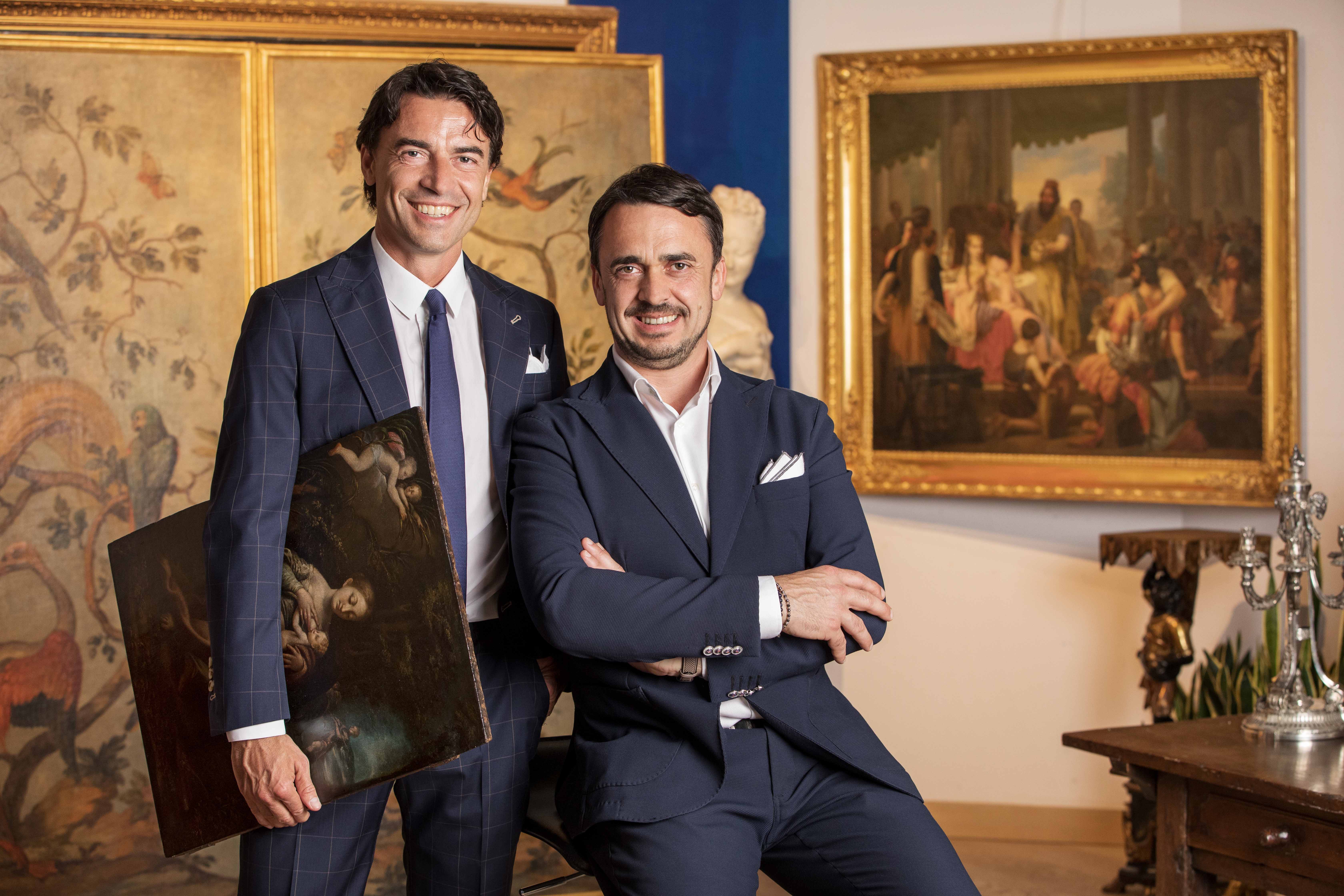
About the Seller
5.0
Vetted Professional Seller
Every seller passes strict standards for authenticity and reliability
Established in 2000
1stDibs seller since 2021
30 sales on 1stDibs
- ShippingRetrieving quote...Shipping from: Milan, Italy
- Return Policy
Authenticity Guarantee
In the unlikely event there’s an issue with an item’s authenticity, contact us within 1 year for a full refund. DetailsMoney-Back Guarantee
If your item is not as described, is damaged in transit, or does not arrive, contact us within 7 days for a full refund. Details24-Hour Cancellation
You have a 24-hour grace period in which to reconsider your purchase, with no questions asked.Vetted Professional Sellers
Our world-class sellers must adhere to strict standards for service and quality, maintaining the integrity of our listings.Price-Match Guarantee
If you find that a seller listed the same item for a lower price elsewhere, we’ll match it.Trusted Global Delivery
Our best-in-class carrier network provides specialized shipping options worldwide, including custom delivery.More From This Seller
View AllEarly 17th Century Roman School Praying Madonna Painting Oil on Canvas
Located in Milan, IT
Roman school, late 16th-early 17th century Praying Madonna
Oil on canvas, 81 x 69 cm
Frame 83 x 95.5 cm
A divine whiteness reverberates with vibrant luster on the maphorion of the present Virgin. The palpable iridescence that structures the thin rosaceous garment, woven with the same fresh light, produces a slight rustle when she takes her hands off. The Madonna in fact takes a prayerful pose, opening her palms to underline her fervent ecstatic intention; the white neck is rendered with perishable fullness of pigments, like the hands, perfectly alive, and the very shiny eyes. With fine shrewdness the artist of the present styles the Virgin's hair with thin white ribbons, exacerbating the purity. An evocative light falls gently on the bust, a materialized sign of divine glory.
The present can be traced back to the late Mannerist climate that prevailed in the capital after the emanation of the Tridentine council (1545-1563). The late Mannerist licenses that can still be seen there, such as the intense lyricism in the stylistic code adopted by the artist, are innervated in the new basic catechetical intent, which at the end of the century produced a certain figurative rigorism. The present, however, still responds to that extraordinary Roman dynamism that raised the capital to a bulwark for the entire mannerist lesson, matched only by a second artistic center, the Florentine one. The engaging carriage of the Virgin reflects the contemporary examples of Giuseppe Valeriano (1542-1596), a Jesuit painter, returning in the Marriage of the Virgin of the Roman Church of Jesus, as well as in the Madonna of Sorrows in the Recanati Altarpiece, equal ardor. But it is in the Assumption of the Virgin painted in four hands with Scipione Pulzone...
Category
Antique Early 17th Century Italian Paintings
Materials
Canvas
18th Century Lying Female Figure Painting by Giovanni Domenico Molinari
Located in Milan, IT
Giovanni Domenico Molinari (Caresana, 1721 - Turin, 1793)
Lying Female figure
Oil on canvas, cm 46 x. 31 - With frame, cm 56 x 42
The present painting is connected by style and treated subject, in this case a young girl lying in an idyllic landscape, to the production of small pictures of pastoral subject of the Piedmontese painter Giovanni Domenico Molinari (Caresana, 1721 - Turin, 1793).
Molinare was born in Caresana (Vercelli) on 19 July 1721 but after losing both his parents he moved to Turin. Here he became, from 1736, a pupil of the Academy of Drawing founded by the painter Claudio Francesco Beaumont (Turin, 4 July 1694 - Turin, 21 June 1766) where he remained as a pensioner until December 1755. Molinari was immediately engaged in the translation of the master’s sketches on cardboard used for the Regia manufacture of tapestries. His early success on the Turin art scene is confirmed by the fact that he joined the Compagnia di San Luca in 1756.
In 1751 he married Margherita Peiroleri, whose brothers Pietro (engraver) and Nicolò (painter) also attended the school. Remained widower count two other marriages first with Lucrezia Elisabetta Burzio and then in 1770 with Domenica Maria Ferrero.
On the death of the master in 1766 Molinari, considered by his contemporaries to be the most faithful interpreter of the master and for his elegant and Arcadian style, which clearly interprets the aesthetic taste of the court, was called to finish the works that remained unfinished, such as the altarpiece for the church of Santa Maria della Scala in Moncalieri depicting the Assumption venerated by Blessed Bernard of Baden and Saint Anthony. Molinari was also well praised by critics and Abbot Lanzi highlighted the quality of the production of historical and mythological subject for the rigorous post-marattesco classicism.
In Turin he worked for Vittorio Amedeo III of Savoy as a portrait painter, executing for him eleven canvases (between 1774 and 1775), but, since 1745, he also supplied tapestry cartoons to the local Fabbrica, of which, in 1766, he became director.
The production of paintings of sacred subjects is also lively, especially used in the decoration of the churches of the capital as the Assumption for the Hotel of Virtue and San Pietro Regalado and San Benedetto il Moro for Santa Maria degli Angeli ( Torino) He also painted tempera and oil cartoons for the same church, on the occasion of the beatification of Pacifico da San Severino (1787) and, for that of San Francesco di Paola, when Gaspare de Bono...
Category
Antique 18th Century Italian Paintings
Materials
Canvas
17th Century Annunciation Painting Oil on Canvas Workshop of Nuvolone
Located in Milan, IT
17th century, Nuvolone workshop
Annunciation
Measures: Oil on canvas, 98.50 x 127.00 cm - with frame 144 x 115
Depicted is a canonical Annunciation which sees Mary on her knees ...
Category
Antique 17th Century Italian Paintings
Materials
Canvas
17th Century Mystical Marriage of Saint Catherine Oli on Canvas Roman School
Located in Milan, IT
17th century, Roman School
Mystical marriage of Saint Catherine of Alexandria
Oil on canvas, 32 x 23 cm
Frame cm 45 x 36
The saint is depicted in front of the Virgin holding the Child portrayed with the wedding ring in his hand, enriched with a precious stone. According to the Golden Legend, Catherine of Alexandria was a very beautiful young woman, the only daughter of the king of Costa, who had refused to marry the emperor Maxentius because she was a Christian and devoted to Christ. Maxentius, unable to convince her to sacrifice to idols, had sent to call the wisest men and fifty philosophers and orators who presented themselves and tried to divert her from faith in Christ. Catherine, however, played so well that she was able to convert them, arousing the anger of the emperor who condemned them to the stake. Catherine, however, who had criticized Maxentius for the new persecutions against the Christians, was sentenced to prison without food. Abandoned for twelve days, she was fed by a dove sent by God. Maxentius then decided to execute her with the torture of the toothed wheel become her attribute iconographic; but by divine intervention this broke and the young was saved. Finally, she was beheaded and milk flowed from her neck. Catherine’s princely status is witnessed here by her sumptuous dress. The iconography of the mystical marriage was born in the fifteenth century, probably because the traditional iconographic attribute, the wheel, was sometimes so small as to look like a ring, and refers to a vision that will always remain present in the mind and heart of the saint. In Heaven she appeared to her, among the Angels and Saints, Christ the Child, in the arms of the Virgin. He took a precious ring that the Virgin Mary handed to her and put it in her finger, saying "I, your Creator and Saviour, take you in marriage; confident that you will keep you pure until you celebrate your eternal wedding with me, in Paradise" When Catherine was laughing, she found in her finger the same ring that she had seen and had in Heaven, and she considered herself forever the bride of Christ.
In this extraordinary episode we can see the heart of Catherine’s religious sense, and of all her spirituality. For her, Christ is like the bridegroom, with whom there is a relationship of intimacy, communion and fidelity; he is the beloved, whom she loves above all...
Category
Antique 17th Century Italian Decorative Art
Materials
Canvas
17th Century Angelica and Medoro Painted Oil on Canvas Roman School
Located in Milan, IT
Roman School, 17th century
Angelica and Medoro engrave their names on the bark of a tree
Oil on canvas, 65 x 48.5 cm
The canvas depicts one of the most famous episodes of O...
Category
Antique 17th Century Italian Paintings
Materials
Canvas
17th Century Madonna with Child Painting Oil on Canvas Tuscan School
Located in Milan, IT
17th century, Tuscan school
Madonna and Child
Oil on canvas, 31 x 21 cm
With frame, cm 37,5 x 27,5
The pearly incarnations and the thoughtful play of looks between the Virgin, turned to the Son, and Questi, warmly open to the viewer, pour out the present painting with compositional perfection. Virginal fabrics become mottled at the folds, wrapping the Madonna in a thin vitreous mantle. The pastel colors, shining on the pink robe just tightened at the waist by a gold cord, enliven the faces of the divine couple in correspondence of the cheeks, lit by an orange warmth. Even the left hand of the Virgin, composed in perfect classical pose (Botticelli, Madonna with Child, 1467, Musée du Petit Palais, Avignon), is sprinkled with warmth thanks to the immediate touch with Christ. From the nimbus of the Mother a delicate luminous disk is effused, which takes back, in the most distant rays, the colour of the hair of the Son, from the tones of the sun. The Child Jesus is represented intent in a tender gesture of invitation with the right hand, while with the other he offers a universal blessing: with his hand he retracts the index and annular palms, extending the remaining three fingers, symbol of Father, Son and Holy Spirit.
The painting welcomes and re-elaborates that typically Tuscan formalism that boasted in the rest of Italy the constant appreciation by the most up-to-date artists and collectors. Arrangement, composition and mixing of colors place the canvas in the middle between the changing mannerist and the sculptural figures of Michelangelo, essential yardstick of comparison in terms of anatomical and expressionistic rendering. In the present, silvery and pinkish powders act as three-dimensional inducers to the Child’s mentioned musculature and to the vivid folds of the clothes, expertly deposited on the lunar whiteness of the skins. While these colours recall the equally brilliantly transparent colours of Pier Francesco Foschi...
Category
Antique 17th Century Italian Paintings
Materials
Canvas
You May Also Like
18th Century Spanish "Penitent Magdalene" Oil on Canvas Following Tiziano
Located in Marbella, ES
18th century Spanish "Penitent Magdalene" oil on canvas in the style of 17th century Italian school, particularly Tiziano models.
Dimension: 101 x 71 cm, 111 x 80 cm (frame).
Category
Antique 17th Century Italian Paintings
Materials
Canvas
Spanish Colonial, Penitent Mary Magdalene, Original O/C Painting, 18th Century
Located in New York, NY
Spanish Colonial
Penitent Mary Magdalene
Original oil on canvas painting
XIX century
Details
Original period frame.
Painting dimensi...
Category
Antique 18th Century Mexican Spanish Colonial Paintings
Materials
Canvas
18th Century Spanish Oil Painting of Mary Magdalene
Located in Round Top, TX
A breathtaking 18th century Spanish oil on canvas painting of Mary Magdalene - Madeleine - in is original frame. Beautiful detail.
Category
Antique Mid-18th Century Spanish Paintings
Materials
Canvas
17th Century Oil on Canvas Antique Religious Italian Painting Magdalene, 1680
Located in Vicoforte, Piedmont
Antique Italian painting from the second half of the 17th century. Artwork oil on canvas depicting a religious subject Penitent Magdalene of excellent pictorial quality. Large size p...
Category
Antique 1680s Italian Paintings
Materials
Canvas
$6,235 Sale Price
20% Off
Free Shipping
Meissen Porcelain Plaque Depicting Mary Magdalene
By Meissen Porcelain
Located in Los Angeles, CA
A large 19th century German Meissen rectangular porcelain plaque depicting Mary Magdalene reclining reading from a book. After Antonio Allegri (Ita...
Category
Antique 1870s German Paintings
Materials
Porcelain
A 19th Century KPM Porcelain Plaque of Mary Magdalene
By KPM Porcelain
Located in Lambertville, NJ
A beautifully painted porcelain plaque in original giltwood frame. The image of Mary Magdalene after the original Italian artist, Pompeo Batoni. The measurements framed are 16 inch...
Category
Antique 19th Century German Paintings
Materials
Porcelain, Giltwood
More Ways To Browse
Christ The King
Luca Cambiaso
R Monti Art
Rainey Bennett
Robert Mcgregor
Roybal Painting
Russian Icon George Slaying
Serge Belloni Painting
Serge Belloni
Severin Roesen
Sir William Russell Flint
Squirrel Man Furniture
Stephanie Hoppen
Steve Burgess
Szasz Paintings
Thomas Pulgini
Turner Airbrush
Used Furniture North Shore Ma
